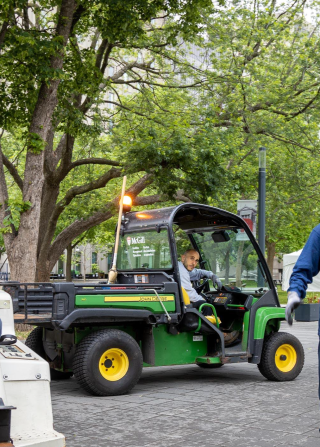Over two thirds of greenhouse gas (GHG) emissions at McGill arise from building energy consumption, in particular natural gas used to heat many buildings on our campuses. Air travel, daily commuting and the University’s fleet of vehicles are some of our other significant emission sources.
Given its number of buildings, campus population and higher proportion of energy-intensive research labs, the downtown campus generates 90% of McGill’s total energy emissions.
 Carbon neutrality by 2040
Carbon neutrality by 2040
One of the long-term targets of McGill’s Climate and Sustainability Strategy 2020 – 2025 is to achieve carbon neutrality by 2040. This means reaching net-zero GHG emissions by completing a series of key actions, to many of which FMAS contributes.
GHG emissions reduction
McGill’s annual GHG assessments show that in 2020, GHG emissions had fallen by 23% compared to 2015.
The natural gas consumption of buildings in 2020 fell by 9% compared to the year before. Contributing factors included the smart energy grids (see more below), which were partially active toward the end of the year, the warmer weather compared to 2019, and the decrease of people on campus due to the pandemic.
Compared to 2002-2003, McGill has reduced its building-related GHG emissions by 34%.
Roadmap
To achieve carbon neutrality, a transition in McGill’s energy systems is of critical importance. FMAS, together with the Office of Sustainability, developed a Roadmap for McGill's Energy Transition. There are several steps in our energy management approach:
- Reduce energy use
- Reuse waste energy
- Transition energy systems
- Procure renewable energy
Reduce energy use
In recent years, McGill has replaced outdated heating, ventilation, and air-conditioning (HVAC) systems in many of its buildings. The new systems are more efficient and help reduce our GHG emissions. Online monitoring of the energy consumed in 70 buildings across the University and the installation of motion-activated lighting in all major buildings helped further reduce energy use.
We continue to explore further potential energy reduction options.
Reuse waste energy
More recently, efforts have been made to minimize our energy requirements. Several smart energy grids, also called heat recovery loops, have been deployed across the downtown campus to optimize energy efficiency by recovering and exchanging heat between buildings.

These loops consist of using the excess heat normally lost through air exhausts or generated by electrical or mechanical equipment to heat or cool other rooms or other buildings.
An example: the heat generated by the data centre in Burnside Hall now meets 20 to 25 percent of the heating needs of Otto Maas.
Over the past few years, smart energy grids have been deployed in the northeast, southwest and southeast sectors of the downtown campus. The coming years will see the deployment of smart energy grids in the north and northwest sectors and at the New Vic.
At the Macdonald campus, energy recovery loops will be implemented in the coming years as HVAC equipment is upgraded in many buildings.
Energy conversion
Converting some heat production systems to electricity is at the heart of McGill’s strategy to reduce emissions.
We are currently replacing one of our natural gas boilers at the downtown campus powerhouse with two off-peak electric boilers and installing a heat recovery unit over the remaining natural gas boilers. This will reduce natural gas consumption on the downtown campus by around 30% and result in a decrease of 25% in the campus’s energy-related emissions and 13% in McGill’s total emissions compared to 2019. The project is expected to be completed by the second quarter of 2023.
Future steps
FMAS aspires to deploy geo-exchange energy systems, also called ground-source energy. This technique uses the ground to store energy that can then be used to heat or cool buildings. Heat pumps extract from or insert heat into the ground, a method that is three to four times more efficient than an electric boiler/heater.
Some specific projects are already envisioned to partly rely on ground-source energy, including the New Vic.
Another alternative solution being considered is the use of renewable natural gas.
Peak demand management
McGill has enrolled in Hydro Quebec’s Peak Demand Management program. This consists of transferring several of our downtown campus buildings to energy delivered by the University’s generators during extreme weather events, such as extremely cold days, when the power demand in Québec peaks.
This helps reduce power demand and the strain on the province’s power infrastructure, contributing to an efficient use of hydroelectricity in Québec and reducing the need for additional electrical production and distribution infrastructure in the province.
Vehicles

In recent years, FMAS has acquired several electric vehicles. Currently, one in five of the vehicles we use on the downtown campus are electric.
This includes:
- Electric vehicles to distribute mail across campus,
- A fully electric mid-sized work truck for our Grounds team,
- Two electric utility vehicles used by our Building Operations team,
- Electric vehicles used by Parking Services.
Moreover, for over ten years Security Services has had bicycle patrol units. The Macdonald campus team also now uses a hybrid vehicle.
Some FMAS vehicles, such as heavy-duty tractors, are currently still more difficult to replace due to a lack of equivalents. McGill aims to procure low-carbon emitting alternatives once the technology progresses.
Charging stations

As of the fall of 2022, there are 21 charging stations on our campuses, 16 of which can be found at the recently renovated McIntyre Medical Building parking garage. Another 41 stations are planned across the downtown and Macdonald campuses and at the Gault Nature Reserve soon.
